Update: For the 2024 tour, the layover day and location and the itinerary past Carmel Hamlet have changed. See the Cycle the Hudson Valley website for details.
Ever since I pedaled 400 miles across my home state of New York, from Buffalo to Albany, in 2011, I had wanted to extend that journey downstate from Albany to New York City. This summer I finally got the chance. I joined about 300 other riders for Cycle the Hudson Valley, a 7-day, 200-mile tour from Troy, just north of Albany, to the tip of Manhattan and across the Brooklyn Bridge.
The Tour and the Trail System
Cycle the Hudson Valley is run by the nonprofit Parks & Trails New York, which describes itself as “New York’s leading statewide advocate for parks and trails.” Its premiere annual event is Cycle the Erie Canal, the tour I rode in 2011. This year marked Parks & Trails’ 25th Cycle the Erie Canal tour and its first annual Cycle the Hudson Valley tour.
Parks & Trails used to run a Hudson Valley tour a few years back, but they discontinued it. This year’s reboot features an almost entirely different and mostly off-road route. It follows the Empire State Trail, a 750-mile multi-use trail system said to be the longest in the country. It was completed relatively recently, at the end of 2020.
The three-part Empire State Trail extends east-west from Buffalo to Albany (the Erie Canalway Trail), north-south from Rouses Point at the Canadian border to Albany (the Champlain Valley Route), and from Albany to New York City (the Hudson Valley Greenway Trail). The Empire State Trail has both off-road and on-road sections. The Champlain Valley Route is mostly on-road. The Erie Canalway Trail and Hudson Valley Greenway Trail are mostly off road.
If you plan to cycle either route as part of a tour or on your own, I highly recommend buying one of Parks & Trails’ excellent guidebooks for the Erie Canal or the Hudson and Champlain Valley routes. They are well organized and structured, contain a wealth of information, and have detailed and easy to follow maps. Between them, they cover the entire Empire State Trail.
Scenes from a Bicycle Tour




The Hudson Valley Route
The route of the Empire State Trail through the Hudson Valley is 76% off road—63% paved trail and 13% crushed stone dust trail. Although we biked alongside or near the Hudson in several places, the overall route doesn’t closely follow the Hudson Valley. It loops widely east and west of the river on rail trails, which allows for a much safer and easier ride.
We crossed the Hudson four times: at Troy, between Albany and Rensselaer, just north of Kingston, and at Poughkeepsie on the Walkway Over the Hudson.
Compared to the Erie Canal route, the Hudson Valley route is much hillier. We had no riding day without some significant hill climbing. The daily elevation gains and distances according to our cue sheets and the Ride with GPS app tell the story:
- 2,022 feet – (50.7 miles) – Troy to Hudson (the longest and hilliest day).
- 1,078 feet – (30.4 miles) – Hudson to Kingston.
- 1,229 feet – (31.4 miles) – Kingston to Poughkeepsie.
- 1,586 feet – (38.3 miles) – Poughkeepsie to Carmel Hamlet.
- 1,281 feet – (39.7 miles) – Carmel Hamlet to Dobbs Ferry.
- 927 feet – (32.2 miles) – Dobbs Ferry to New York City.
That’s more than 8,000 feet of elevation gain in 6 days and 223 miles, not counting optional side trips or layover day rides. The steepest hills tended to be where we had to depart from the main route to reach our overnight camping sites or to detour around one section of trail closed due to recent flood damage. I resorted to walking up stretches of at least half a dozen steep hills, as I felt no need to overstrain my less than youthful muscles. I had nothing to prove.
An e-bike would have helped, but they were not permitted on this tour because of some local restrictions. This is likely to change in the future, as those localities come to terms with the ubiquitousness of motor-assisted bikes and the need to accommodate them. [Update: the e-bike restriction has changed. See the FAQ section of the tour website.]
Along the Trail


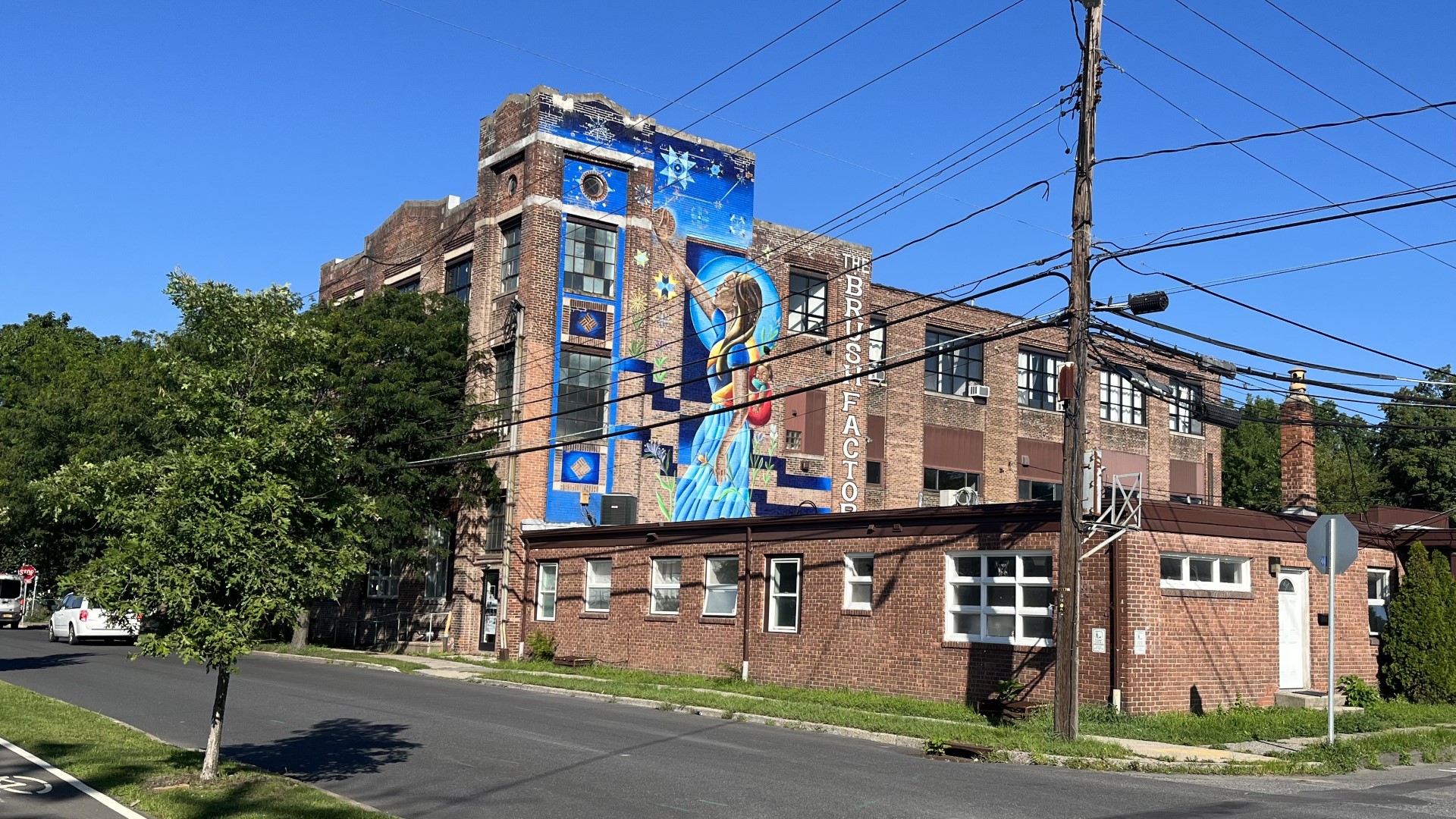




The Off-Road Trails
Skimming through the maps in my Cycling the Hudson Valley guide, I counted 12 trails that we biked, most of them for substantial distances. From north to south:
- Mohawk Hudson Bike Hike Trail – Troy to Rensselaer.
- Albany-Hudson Electric Trail – Rensselaer to Hudson.
- Kingston Point Rail Trail – Kingston waterfront to downtown.
- Wallkill Valley Rail Trail – Kingston to New Paltz.
- Hudson Valley Rail Trail – New Paltz to Poughkeepsie.
- Walkway Over the Hudson – Poughkeepsie.
- WRS Dutchess Rail Trail –Poughkeepsie to Hopewell Junction.
- Maybrook Trailway – Hopewell Junction to Brewster.
- Putnam Trailway – Brewster to Mahopac.
- North County Trail – Mahopac to Elmsford.
- South County Trail – Elmsford to the Bronx.
- Manhattan Greenway Trail – Manhattan.
The one gap in this list is the route from Hudson to Kingston, which is almost entirely on rural, low-traffic roads. Every other day we were mostly on trails.
My least favorite trails were the Albany-Hudson Electric Trail (gaps in several places, hilly, less scenic) and the Putnam Trailway (older, bumpy in spots, hilly). The Manhattan Greenway Trail was the most urban, busiest, and least relaxing ride.
The short Kingston Point Rail Trail provided a much gentler uphill climb from the waterfront to downtown than any street route. The Walkway Over the Hudson was 1.3 miles of pure pleasure, the best crossing over the river. We had the bridge almost to ourselves, but I’m told it’s packed on weekends.
The Wallkill Valley Trail was the only trail that was almost entirely unpaved, but it was a pretty smooth ride. One stretch was a little rougher, but some interesting ruins of former cement works along the way made up for that. The Wallkill was one my two favorite trails.
The Dutchess and Maybrook trails provided a scenic and long but gentle 26-mile climb between Poughkeepsie and Carmel, which was easy on my legs but agony on my butt.
My other favorite trail was the North County Trail, a mostly downhill relief after the previous day’s long climb on the Dutchess and Maybrook trails. It was a lovely ride through woods and rocky terrain, at least until it reached the Taconic State Parkway. From then on, for the rest of our tour route, we were almost always within sight or sound of urban traffic.
Wayfinding was a combination of printed cue sheets, route maps and verbal directions via the Ride with GPS app (access provided for free), and directional arrows painted on pavement. Signs for Empire State Trail or Hudson Valley Greenway Trail provided further clues. I relied on all of these at different times, yet I still got momentarily confused or uncertain in several spots, notably at New Paltz and the Bronx.
On the Bridges
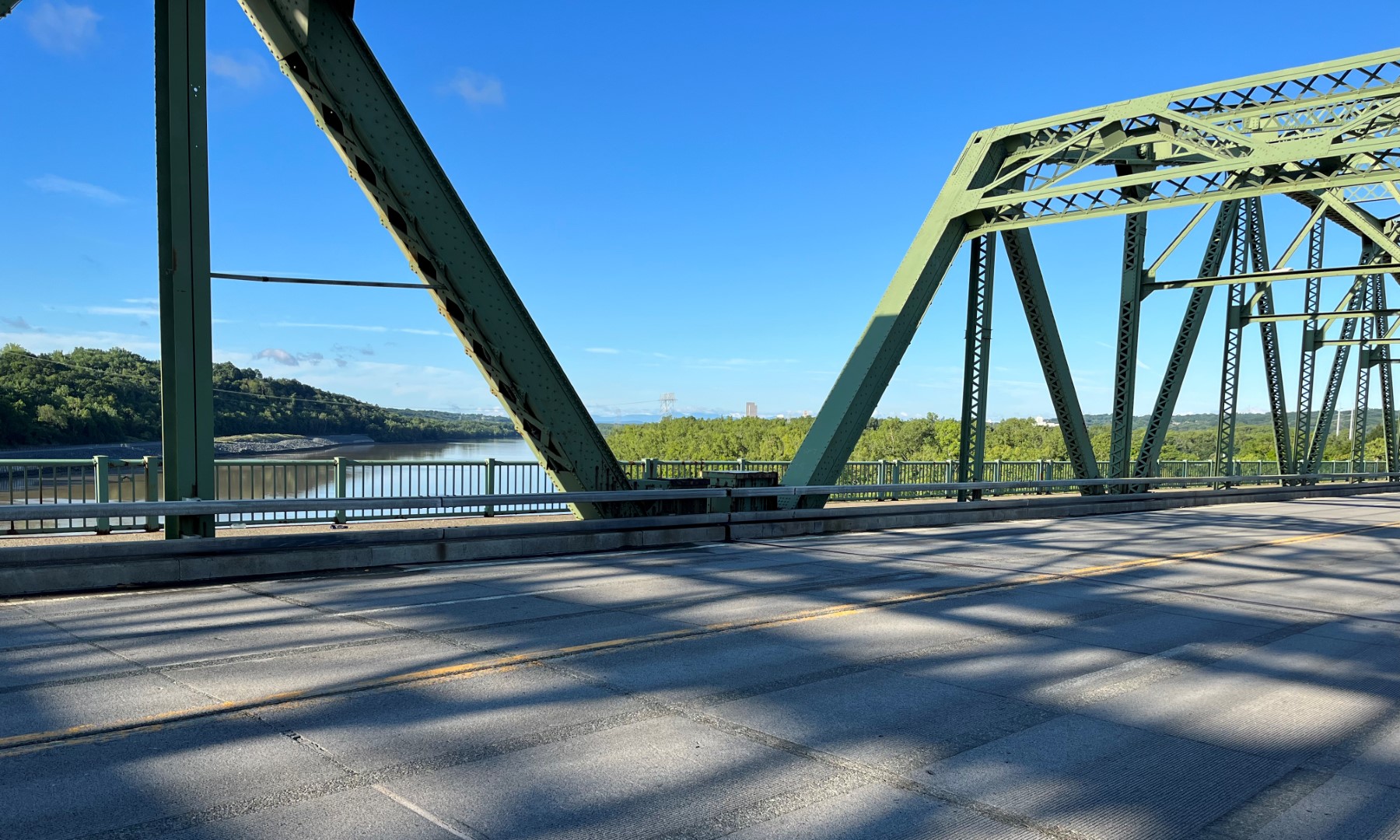

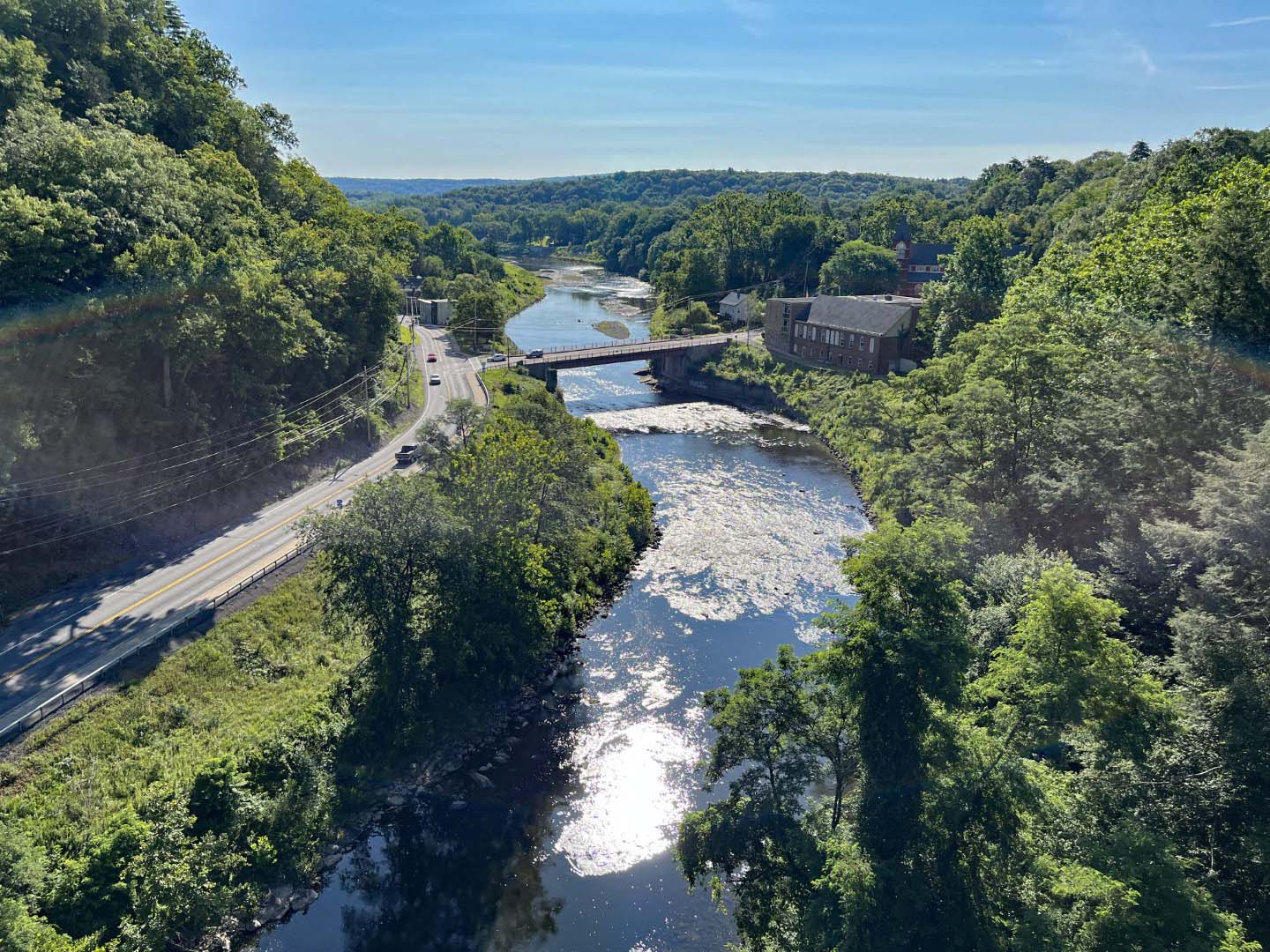

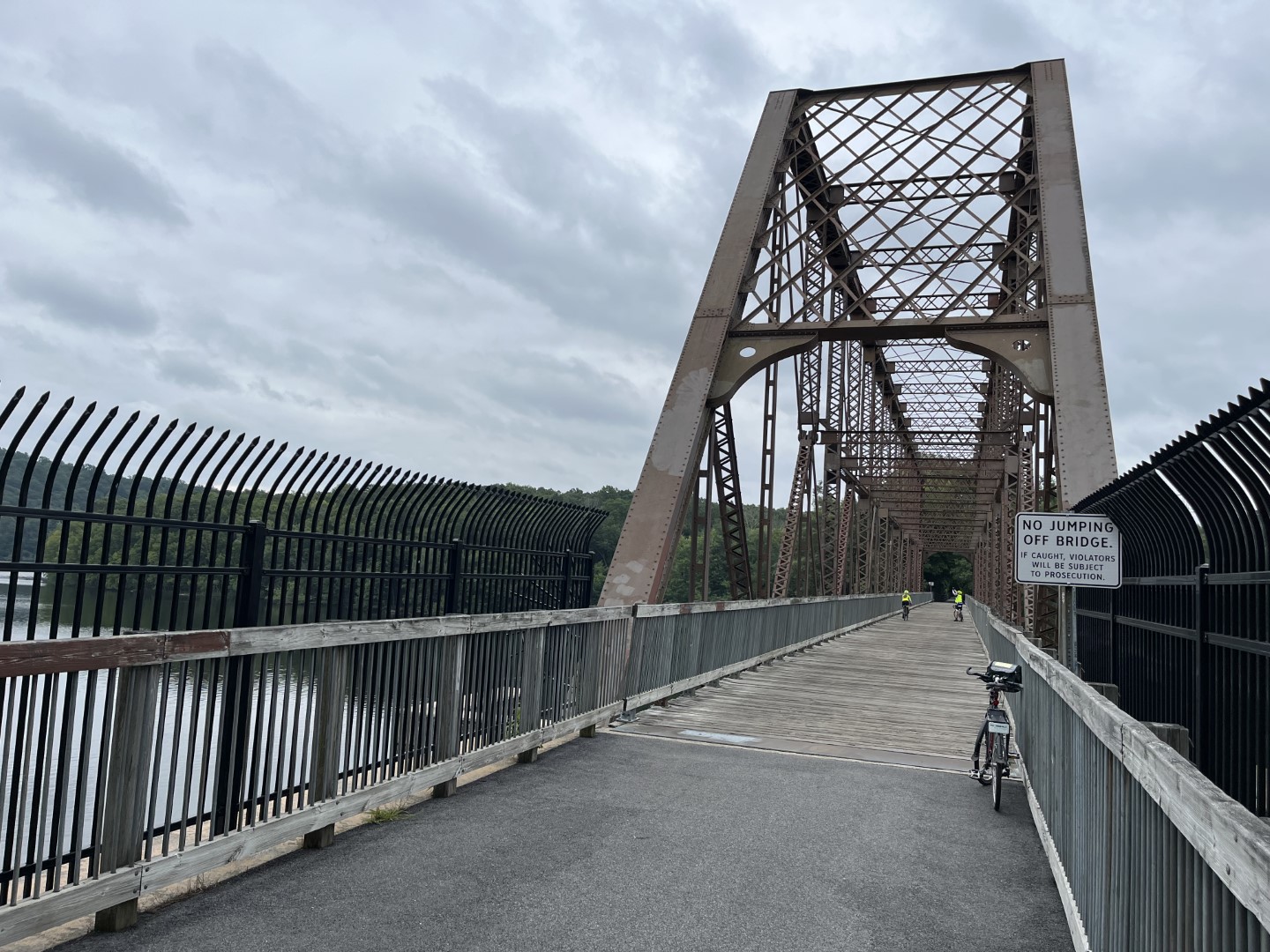


Logistics and Camping
Touring cyclists have long considered Parks & Trails’ Cycle the Erie Canal ride a well-run and uniquely enjoyable tour. Its inaugural Cycle the Hudson Valley tour lived up to that reputation.
Our group gathered at Hudson Valley Community College in Troy on Saturday, July 29. We set out from Troy on Sunday and finished in New York City the following Saturday. Our one layover day occurred rather early in the trip, but Kingston seemed like the logical place for it.
Camping was usually on college campuses, where we had access to indoor restroom and shower facilities, supplemented by a shower truck and porta-potties. One exception was at Kingston, where we stayed for two nights at Hutton Brickyards, a former industrial site that’s been converted into a resort. The other was at Carmel Hamlet, where we stayed at the Paladin Center, some sort of law enforcement training facility and indoor shooting range. The grounds there were fine for camping, but the building was poorly maintained and had no shower facilities. I hope Parks & Trails finds a better alternative in the future. There was no indoor camping available at any of the sites.
Hutton Brickyards and a River Cruise

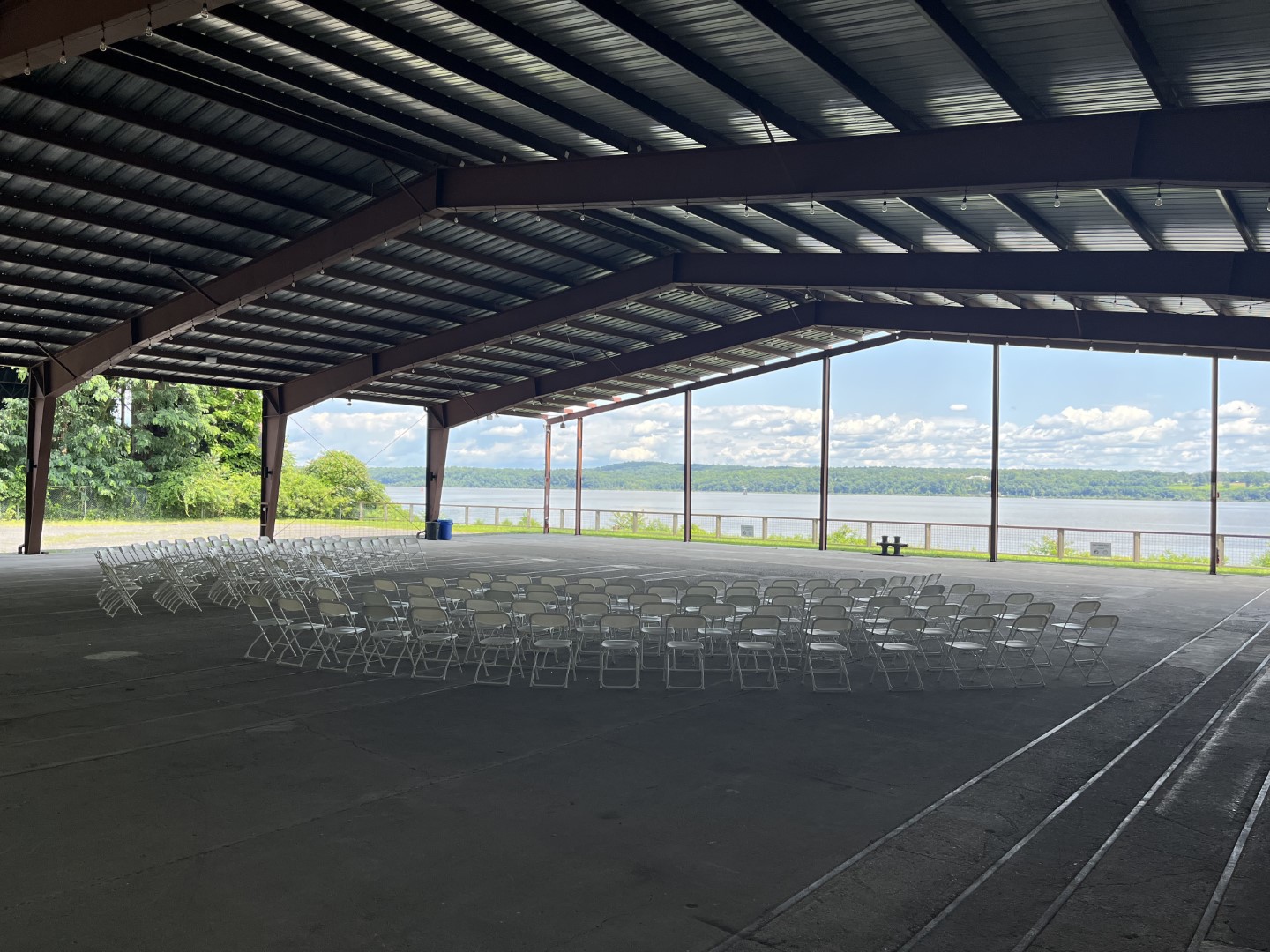

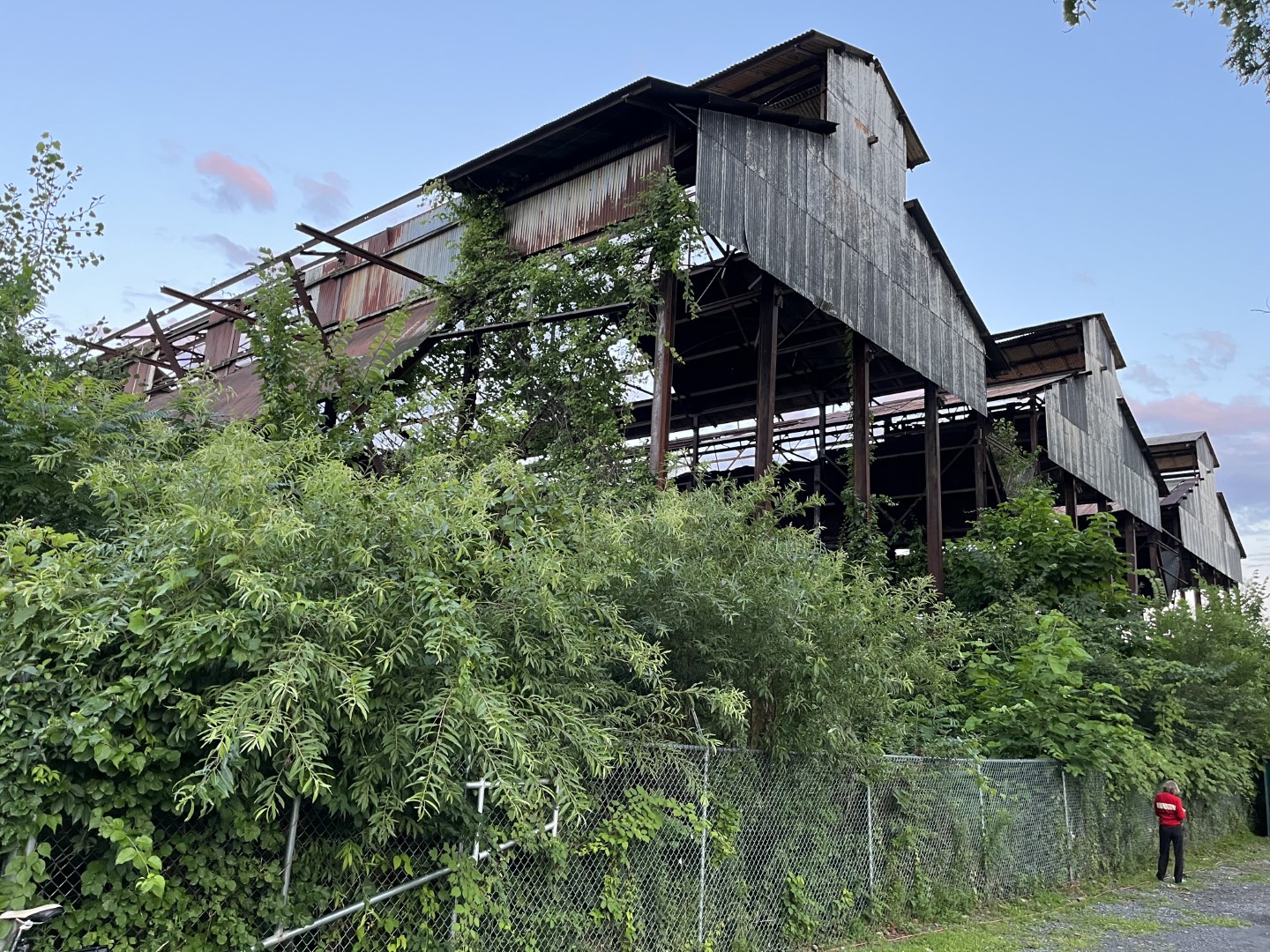

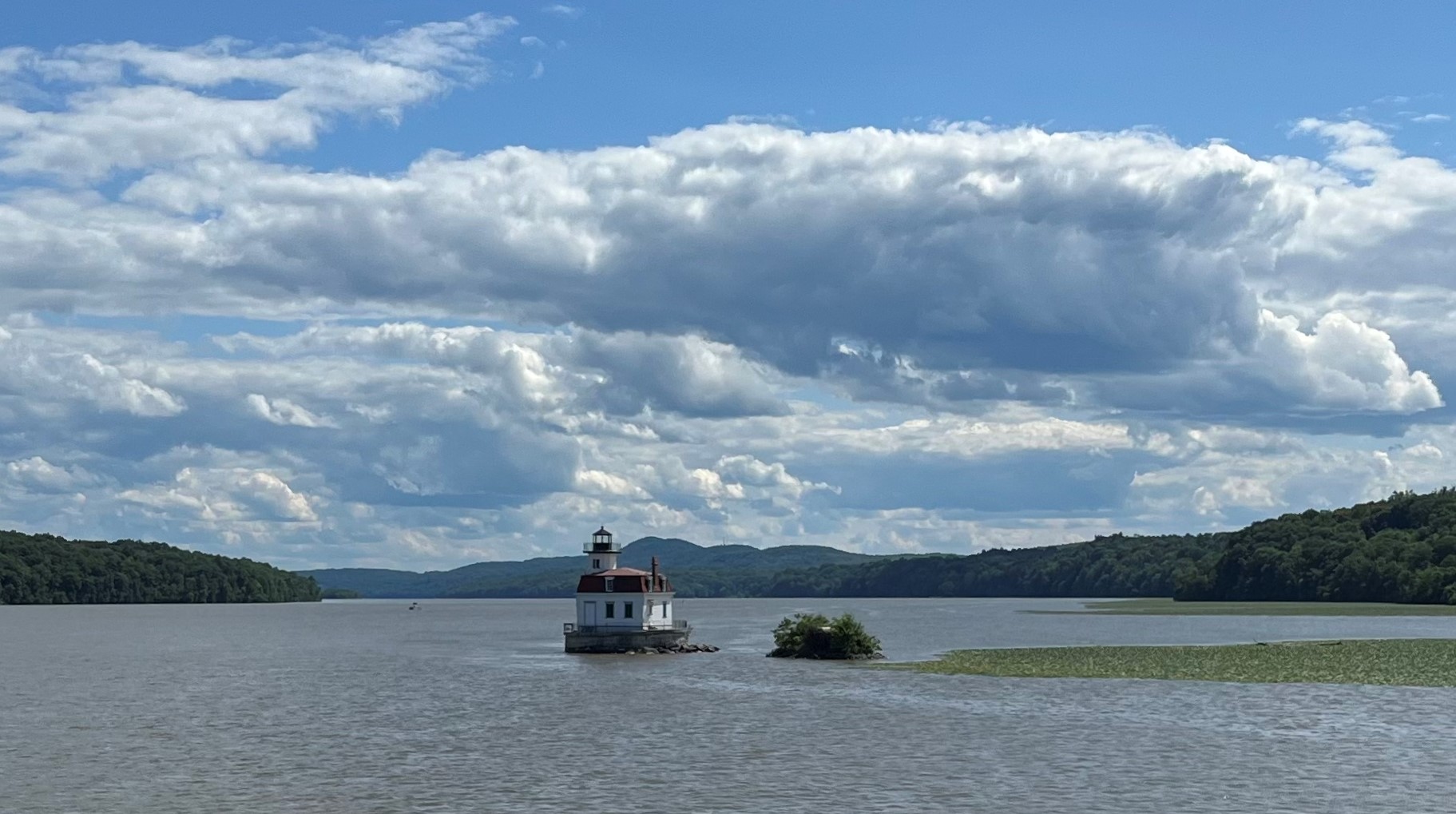

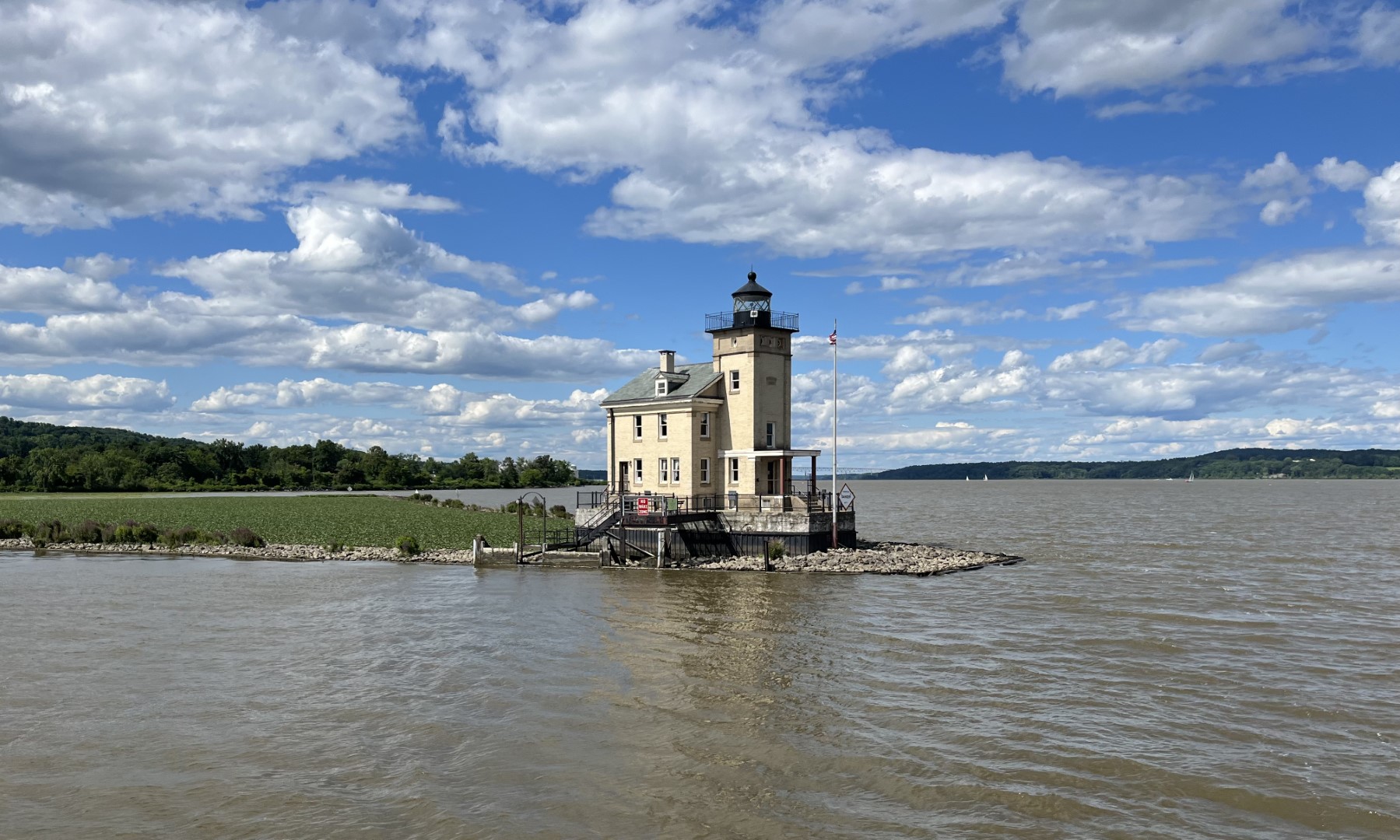
Meals and More
All breakfasts and four dinners were provided. We were on our own for three dinners: at Hudson, on our layover day in Kingston, and at Carmel Hamlet. Buses were available to shuttle us into those towns. I’ve learned not to expect memorably good catered meals on bicycle tours, and I thought the meals this time were adequate but mostly unexceptional. There were a couple of nice appetizer receptions and two breakfast spreads I thought were unusually good. So, no complaints.
The twice-daily rest stops, set up and staffed by teams of cheerful and hardworking volunteers from the tour group, were as welcome and well run as usual. At two rest stops, we were treated to something extra by locals. At a farm rest stop, we enjoyed fresh hardboiled eggs, fresh-picked fruit, and homemade quiche. At another, we enjoyed sampling (repeatedly) locally smoked bacon and sausages. Those were memorable eats.
There were opportunities for side trips to the town of Rheinbeck and the Old Rheinbeck Aerodrome, the new Tappan Zee Bridge (or whatever it’s called now), and other places. Riders could sign up for a bus trip to the Culinary Institute of America, take a cruise on the Hudson River, and enjoy evening talks and music. There was no lack of things to do or see.
Other than a storm front that blew through while we were all indoors for our initial gathering in Troy, the weather for the entire week was about as perfect as we could have wished for. Not too hot, not too cold, no rain, no strong headwinds. Seven almost flawless riding days.
At the Rest Stops
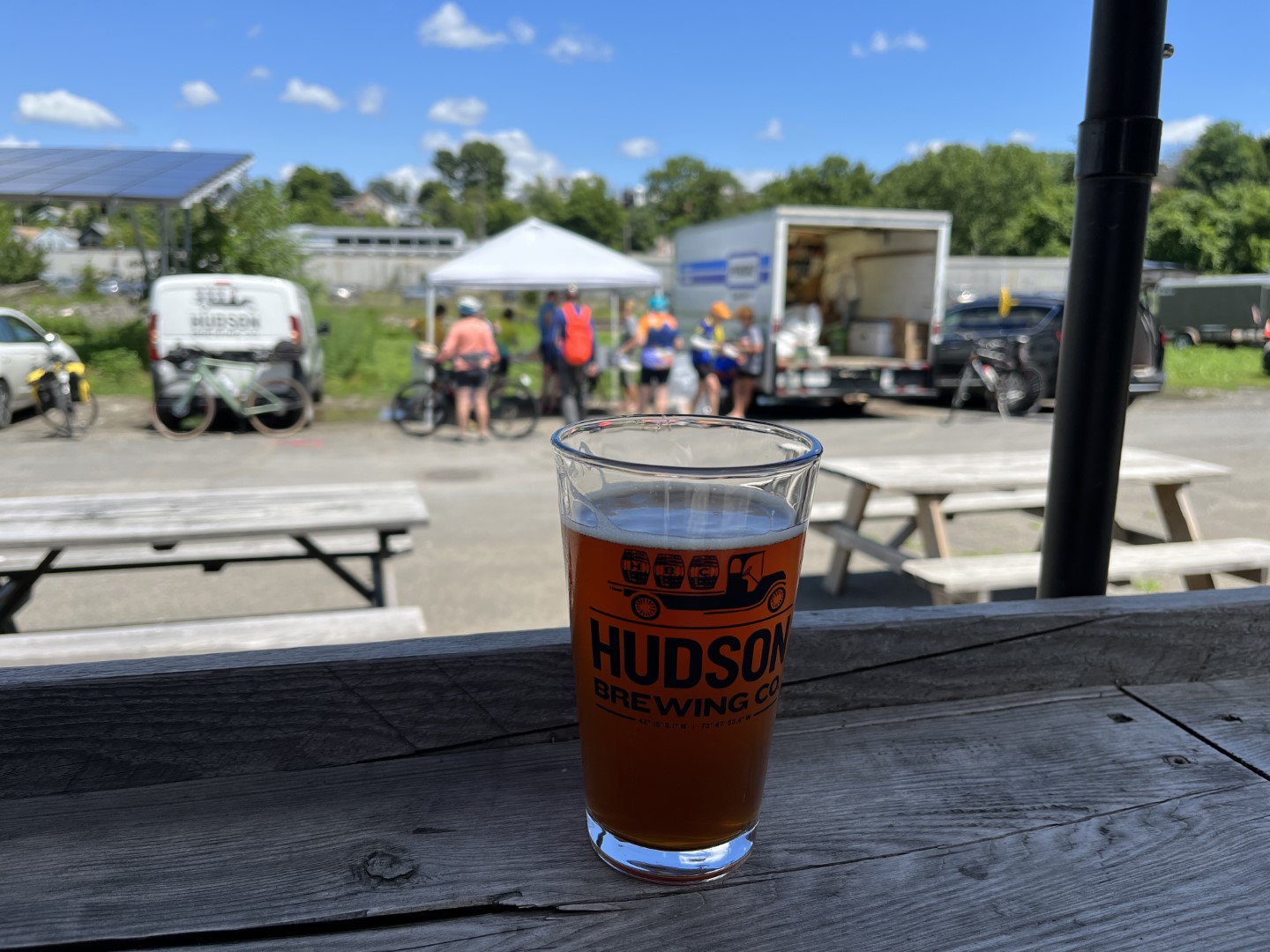
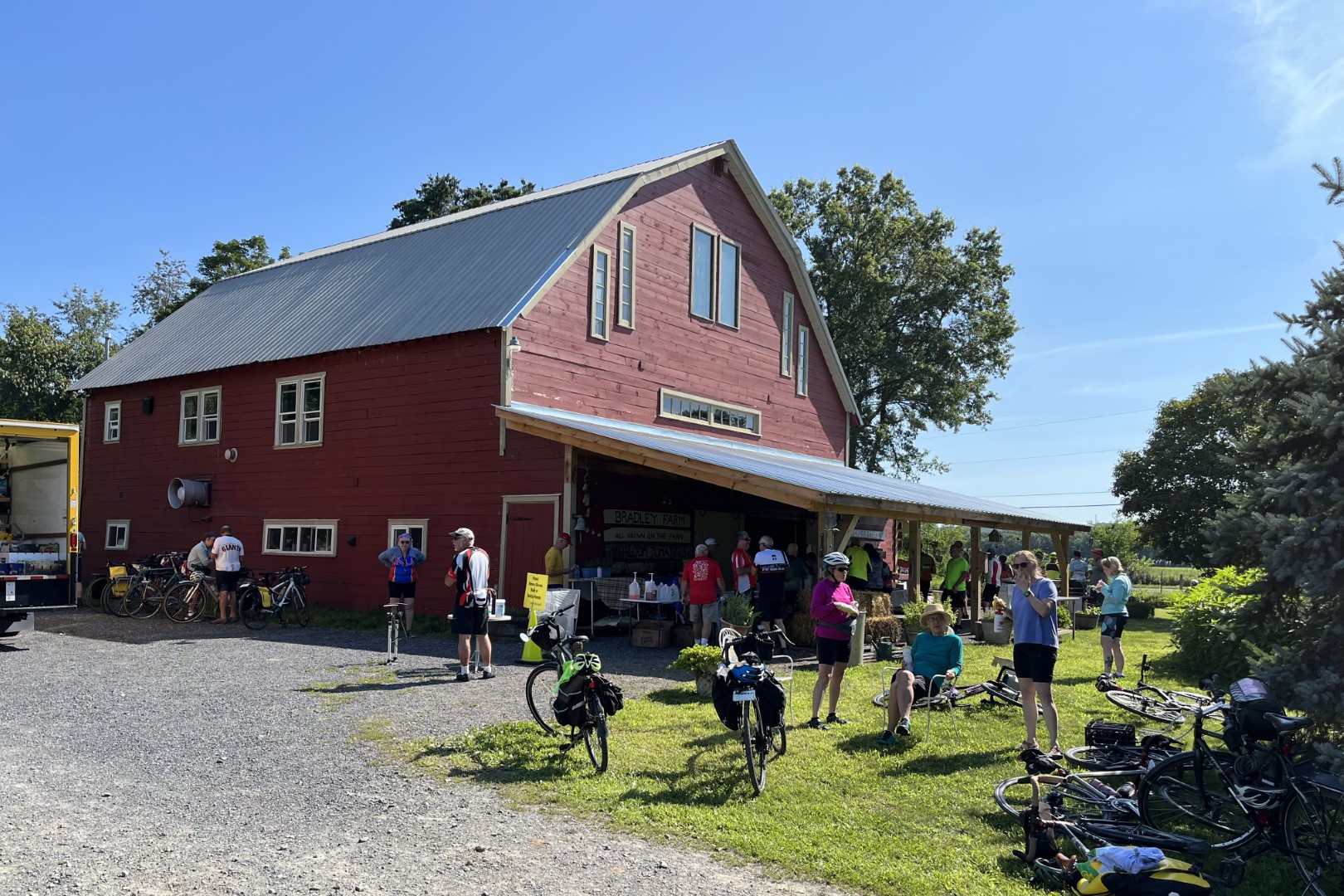


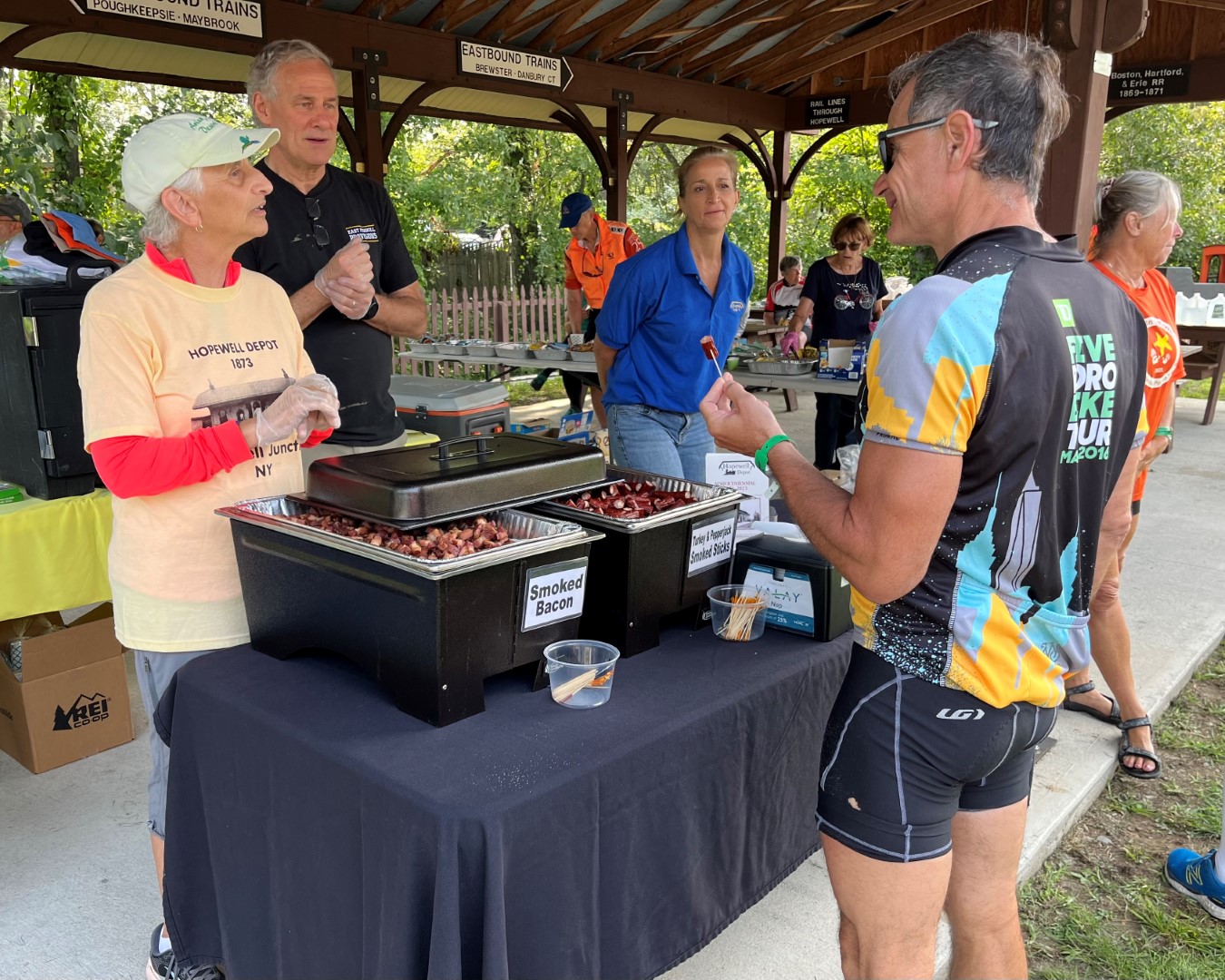
One Snafu and an Unwelcome Souvenir
The only major snafu I was aware of occurred on the final day. Our ending point was Brooklyn Bridge Park. There, those of us parked in Troy had to load our bikes onto a truck and load ourselves onto buses that would shuttle us back upstate. A detailed schedule had been established to get everyone to the finish and out of the city on time. Bikes had to loaded onto the truck by 3:00. The shuttle buses were supposed to depart by 3:30, with an estimated arrival time of 7:00 p.m. in Troy.
But the buses were late, stuck in Manhattan traffic. Many of us spent the better part of the afternoon sitting around waiting to leave, during which time I began feeling congested and vaguely sick.
We didn’t depart until about 4:30 for the agonizingly slow drive through Manhattan and the long drive north on the Thruway. It was 8:15 and getting dark by the time we arrived at the campus in Troy, where the bus driver dropped us off in the center of campus, not near the garage where our cars were parked or where our luggage and bikes had been unloaded. It was 9:20 before I arrived, hungry and beat, at my friends’ house where I was staying that night.
Early the next morning, still feeling congested and just to be on the safe side, I took a covid test. I tested positive, for the very first time.
As I write this, several days later, I’m feeling fine and testing negative again. My bout with covid has been mild, and I haven’t infected anyone that I know.
New York City





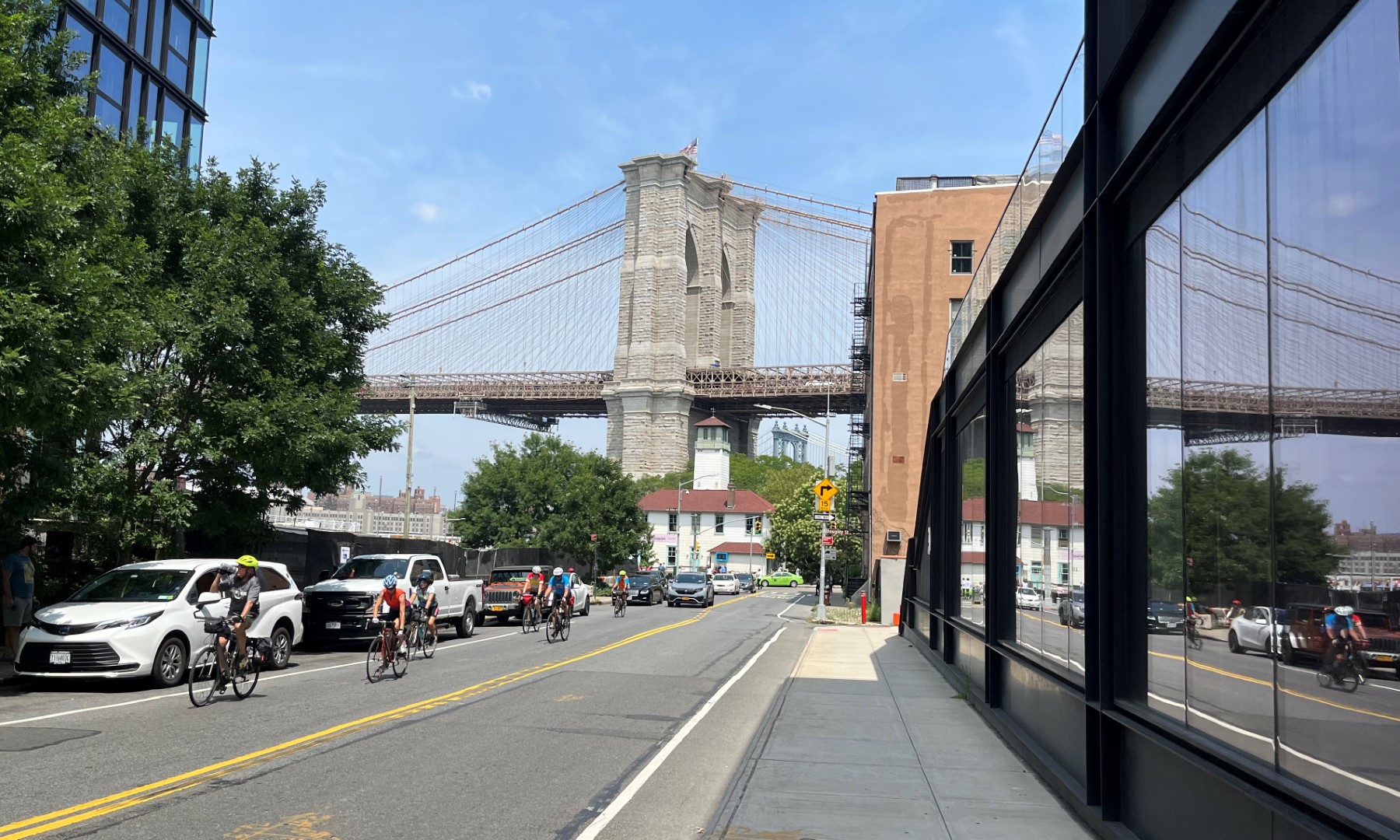

Epilogue
When I arrived home on Sunday afternoon after an 8-hour drive and unloaded my car, I discovered that the rear tire on my Trek 520 was dead flat. It had been fine while traveling all the way down Manhattan and across the Brooklyn Bridge. It hadn’t been flat when I loaded it onto the truck for Troy. I’m almost certain it hadn’t been flat when I retrieved and loaded it onto my car that night. How the hell could this have happened, I wondered?
The next day, I pulled off the tire and discovered that a glass shard had sliced through the tread and the thick inner layer and pricked the inner tube. Examining the tire more closely, I picked out other bits of stone and glass and noticed how worn the tread was and how many more cuts and holes it bore. I also discovered an inch-long crack in the rear wheel rim that could only have happened at least five years ago.
And yet my trusty Trek had somehow gotten me down the last mile of the last day of what may be my last bicycle tour of this kind, before finally allowing its punctured tire to fail. That’s the kind of companion it’s been over 20 years of riding and more than 30,000 miles. Once I’ve replaced its battered tire, had a clicking bearing fixed, and maybe put a Band-Aid on its rim, I plan to keep on riding with it, in new directions I’ve yet to decide, I hope for years to come.
Links
David Romanowski, 2023



Very nicely written! I especially like how you worded the parting present provided! The trip will become a pleasant memory for you to share, snafu’s and all.
LikeLiked by 1 person
Thanks Tad! Glad I didn’t share my souvenir with you!
LikeLike
Hi Dave, once again you have provided a wonderful travelog. It was great to see you!!
Fred
LikeLiked by 1 person
Thanks Fred! I really enjoyed rendezvousing with you and Deb in Hudson!
LikeLike
A wonderful story. I have done the Erie Canal ride twice, once in each direction and have always wanted to do the Hudson ride…still a dream.
LikeLiked by 1 person
Thank you! I encourage you to look into it.
LikeLike
Thanks David for the well written concise article. What memories. Wonderful working and riding with youl. Looking forward to another great Adventure.
LikeLiked by 1 person
Thanks Bob! You might be interested in my previous post, about volunteering on the Erie Canal tour. I’m considering doing that again next summer, perhaps for the entire tour this time, but it will depend on how the timing works out with another, more local volunteer effort I hope to start in 2024.
LikeLike
Wonderful. I hae another blog to find and read.
Both Annie & I signed up today to volunteer for Erie & Hudson today. Had a confrence call with new Hudson director. Very pleased with improvments.
LikeLiked by 1 person
Thanks for subscribing Bob. I don’t post new writeups very often on this blog (or my other one for that matter). So you won’t be overwhelmed with notices of new postings. I’ll have to look into volunteering for the Erie Canal trip and see what I can work out. I’ll be interested to find out what’s changed about the Hudson tour.
LikeLike